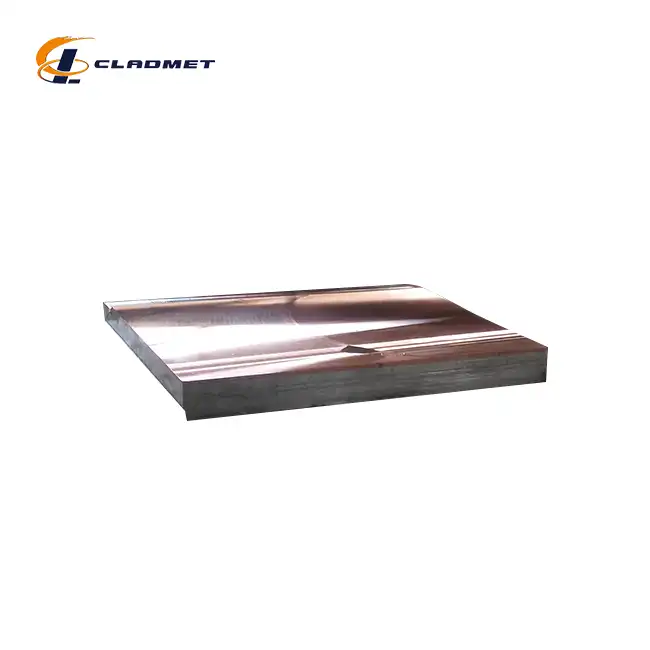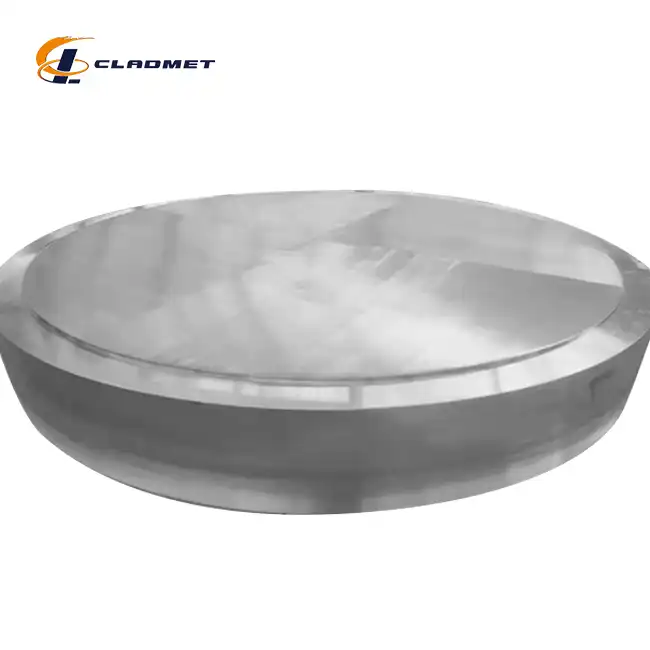How Is Stainless Clad Steel Sheet Manufactured Using Explosive Bonding?
 2025-07-25 09:48:19
View:389
2025-07-25 09:48:19
View:389The manufacturing of stainless clad steel sheet through explosive bonding represents one of the most advanced and effective metallurgical processes in modern industrial applications. This sophisticated technique creates a permanent, high-strength bond between stainless steel and base metals, producing composite materials that combine the superior corrosion resistance of stainless steel with the structural integrity and cost-effectiveness of carbon steel substrates. Explosive bonding utilizes controlled detonation forces to achieve metallurgical bonding at the atomic level, creating stainless clad steel sheet products that meet the demanding requirements of chemical processing, oil and gas, marine, and power generation industries.

Understanding the Explosive Bonding Process for Stainless Clad Steel Sheet
Material Preparation and Selection Requirements
The explosive bonding process for stainless clad steel sheet begins with meticulous material preparation and selection protocols that ensure optimal bonding conditions. Prior to the explosive bonding procedure, both the base material and stainless steel cladding layer undergo comprehensive surface preparation treatments to remove any oxidation, contaminants, or surface irregularities that could compromise the bonding integrity. The base metal, typically carbon steel grades such as Q235 or Q345, is carefully cleaned using mechanical and chemical methods to achieve the required surface roughness and cleanliness standards. The stainless steel cladding material, which can include various grades such as 304, 316, 321, or 2205 depending on the specific application requirements, undergoes similar preparation processes to ensure optimal bonding surfaces. The selection of appropriate material combinations is crucial for achieving the desired mechanical properties and corrosion resistance characteristics in the final stainless clad steel sheet product. Quality control measures during this preparation phase include dimensional verification, chemical composition analysis, and surface quality inspection to ensure compliance with international standards such as ASME, ASTM, and JIS specifications.
Explosive Charge Configuration and Detonation Control
The explosive charge configuration and detonation control system represents the heart of the explosive bonding process for stainless clad steel sheet manufacturing. The explosive material, typically a high-energy compound specifically designed for metallurgical bonding applications, is precisely positioned between the stainless steel cladding layer and the base metal substrate. The explosive charge distribution must be carefully calculated to ensure uniform detonation velocity and pressure distribution across the entire bonding surface area. Advanced detonation control systems utilize multiple initiation points strategically placed to create a controlled wave propagation pattern that optimizes the collision angle and velocity between the bonding materials. The detonation velocity typically ranges from 2000 to 4000 meters per second, generating pressures exceeding 10 GPa at the bonding interface. This high-velocity impact creates a phenomenon known as "jetting," where microscopic jets of material are expelled from the bonding interface, effectively removing surface contaminants and creating ideal conditions for metallurgical bonding. The precise control of explosive parameters ensures consistent bond quality throughout the stainless clad steel sheet while maintaining the integrity of both the base material and cladding layer.
Metallurgical Bonding Mechanisms and Interface Formation
The metallurgical bonding mechanisms that occur during explosive bonding of stainless clad steel sheet involve complex physical and chemical processes that create permanent atomic-level bonds between the dissimilar materials. When the controlled detonation occurs, the collision between the stainless steel cladding and base metal creates extreme localized pressures and temperatures at the bonding interface, causing plastic deformation and atomic interdiffusion. The high-velocity impact generates shock waves that propagate through both materials, creating a characteristic wavy interface pattern that significantly increases the bonding surface area and mechanical interlocking between the layers. This wavy interface, combined with the metallurgical bonding achieved through atomic diffusion, creates a bond strength that often exceeds the strength of the weaker base material. The bonding process occurs in microseconds, with the rapid cooling that follows preserving the metallurgical structure and preventing the formation of brittle intermetallic compounds that could compromise the stainless clad steel sheet performance. Advanced microscopic analysis techniques reveal that the bonding interface exhibits a continuous transition zone where the chemical composition gradually changes from the base metal to the stainless steel cladding, ensuring excellent mechanical properties and corrosion resistance throughout the composite structure.
Technical Specifications and Quality Control in Explosive Bonding
Dimensional Tolerances and Thickness Control Parameters
The dimensional tolerances and thickness control parameters for stainless clad steel sheet manufactured through explosive bonding require precise engineering specifications to meet the exacting requirements of various industrial applications. The total thickness of the composite material typically ranges from 6mm to 150mm, with cladding thickness options spanning from 2mm to 20mm, depending on the specific application requirements and performance criteria. The explosive bonding process must maintain strict dimensional tolerances to ensure uniform cladding thickness across the entire sheet surface, with typical tolerance ranges of ±0.5mm for total thickness and ±0.2mm for cladding thickness uniformity. Advanced measurement systems utilize ultrasonic thickness gauging and coordinate measuring machines to verify dimensional accuracy throughout the production process. The bonding process parameters are carefully optimized to prevent excessive deformation of the base material while ensuring complete bonding coverage across the stainless clad steel sheet surface. Quality control protocols include statistical process control methods to monitor thickness variations, bond strength consistency, and surface quality parameters. The dimensional stability of the final product is verified through comprehensive testing procedures that include flatness measurements, edge squareness verification, and surface finish evaluation to ensure compliance with customer specifications and international standards.
Bond Strength Testing and Mechanical Property Verification
Bond strength testing and mechanical property verification represent critical quality assurance measures in the production of stainless clad steel sheet through explosive bonding processes. The bond strength between the stainless steel cladding and base metal is evaluated using standardized testing methods including tensile testing, shear testing, and bend testing procedures that simulate real-world loading conditions. Typical bond strength values achieved through explosive bonding exceed 350 MPa in tensile applications and 250 MPa in shear applications, demonstrating the superior mechanical integrity of the composite material. The mechanical property verification process includes comprehensive testing of the base material, cladding layer, and bonded interface to ensure that the stainless clad steel sheet maintains the required strength characteristics throughout its service life. Advanced testing techniques such as ultrasonic inspection, radiographic examination, and magnetic particle testing are employed to detect any potential bonding defects or discontinuities that could compromise the structural integrity of the final product. The mechanical properties of the composite material are verified through standardized testing procedures that evaluate yield strength, ultimate tensile strength, elongation, and impact resistance characteristics. Quality control measures ensure that each batch of stainless clad steel sheet meets or exceeds the specified mechanical property requirements while maintaining consistent performance characteristics across the entire production run.
Surface Quality and Corrosion Resistance Assessment
Surface quality and corrosion resistance assessment protocols for stainless clad steel sheet manufactured through explosive bonding ensure that the final product meets the stringent requirements for chemical processing, marine, and industrial applications. The surface finish of the stainless steel cladding can be customized to meet specific application requirements, with options including polished, brushed, or coated finishes that provide enhanced aesthetic appeal and functional performance. The explosive bonding process preserves the inherent corrosion resistance properties of the stainless steel cladding while maintaining the structural integrity of the composite material. Corrosion resistance testing includes exposure to various chemical environments, salt spray testing, and electrochemical corrosion studies that evaluate the long-term performance of the stainless clad steel sheet under service conditions. The bonding interface integrity is particularly important for corrosion resistance, as any defects or discontinuities could provide pathways for corrosive attack on the base material. Advanced surface analysis techniques including scanning electron microscopy and energy-dispersive X-ray spectroscopy are utilized to characterize the surface morphology and chemical composition of the bonding interface. Quality assurance protocols ensure that the surface quality and corrosion resistance characteristics of the stainless clad steel sheet meet or exceed the requirements specified in international standards such as ASTM, ASME, and JIS specifications.

Applications and Performance Advantages in Industrial Environments
Chemical Processing and Petrochemical Industry Applications
The chemical processing and petrochemical industry represents one of the most demanding applications for stainless clad steel sheet manufactured through explosive bonding, where the combination of superior corrosion resistance and structural integrity is essential for safe and reliable operation. In these environments, the stainless steel cladding provides excellent resistance to aggressive chemical media, including acids, bases, and corrosive gases, while the carbon steel base material offers the necessary mechanical strength and cost-effectiveness for large-scale industrial equipment. The explosive bonding process creates a metallurgical bond that maintains its integrity under the extreme temperature and pressure conditions commonly encountered in chemical processing applications. Typical applications include reactor vessels, heat exchangers, distillation columns, and storage tanks where the stainless clad steel sheet provides long-term performance advantages over conventional materials. The dual-layer structure of the composite material ensures that even if the stainless steel cladding experiences localized damage, the underlying base material continues to provide structural support while the remaining cladding area maintains corrosion protection. Quality control measures for chemical processing applications include specialized testing procedures that evaluate the material's resistance to specific chemical environments, thermal cycling performance, and long-term stability under operating conditions. The customizable nature of stainless clad steel sheet allows engineers to optimize the material composition and thickness specifications for specific chemical processing applications, ensuring optimal performance and cost-effectiveness.
Marine and Offshore Engineering Solutions
Marine and offshore engineering applications present unique challenges that require the exceptional performance characteristics of stainless clad steel sheet manufactured through explosive bonding processes. The marine environment's combination of saltwater exposure, temperature variations, and mechanical stresses demands materials that can withstand prolonged exposure to corrosive conditions while maintaining structural integrity. The stainless steel cladding provides superior resistance to chloride-induced corrosion, pitting, and crevice corrosion that are common failure modes in marine applications. The explosive bonding process ensures that the bond between the stainless steel cladding and base material remains intact even under the dynamic loading conditions experienced in marine environments. Applications include ship hulls, offshore platforms, desalination equipment, and marine heat exchangers where the stainless clad steel sheet provides enhanced durability and reduced maintenance requirements compared to conventional materials. The material's ability to withstand both atmospheric corrosion and seawater immersion makes it ideal for components that experience varying exposure conditions throughout their service life. Advanced testing protocols for marine applications include accelerated corrosion testing, fatigue analysis under cyclic loading, and evaluation of galvanic compatibility with other materials commonly used in marine construction. The customizable thickness options for stainless clad steel sheet allow engineers to optimize the material design for specific marine applications, balancing corrosion protection requirements with structural performance and cost considerations.
Power Generation and Energy Sector Implementations
Power generation and energy sector implementations of stainless clad steel sheet manufactured through explosive bonding address the critical requirements for materials that can withstand high-temperature, high-pressure, and corrosive environments while maintaining long-term reliability and performance. In thermal power plants, the stainless steel cladding provides excellent resistance to oxidation, sulfidation, and other high-temperature corrosion mechanisms, while the carbon steel base material offers the necessary strength and thermal conductivity for efficient heat transfer applications. The explosive bonding process creates a metallurgical bond that maintains its integrity under the thermal cycling conditions commonly experienced in power generation equipment. Applications include boiler tubes, heat exchanger components, steam generators, and pressure vessels where the stainless clad steel sheet provides enhanced performance compared to conventional materials. The material's ability to withstand both aqueous and gaseous corrosion environments makes it particularly suitable for components that experience varying operating conditions throughout their service life. In nuclear power applications, the stainless clad steel sheet provides additional advantages including radiation resistance, low neutron absorption, and compatibility with nuclear coolant systems. Quality control measures for power generation applications include specialized testing procedures that evaluate the material's performance under simulated operating conditions, including thermal shock testing, pressure cycling analysis, and long-term creep resistance evaluation. The customizable nature of stainless clad steel sheet allows power plant engineers to optimize the material specifications for specific applications, ensuring optimal performance, safety, and operational reliability.
Conclusion
The explosive bonding process for manufacturing stainless clad steel sheet represents a pinnacle of metallurgical engineering that delivers superior performance characteristics for demanding industrial applications. Through precise control of explosive parameters, material preparation, and quality assurance protocols, this advanced manufacturing technique creates composite materials that combine the best properties of stainless steel and carbon steel substrates. The resulting stainless clad steel sheet offers exceptional corrosion resistance, mechanical strength, and cost-effectiveness, making it an ideal solution for chemical processing, marine engineering, and power generation applications where reliability and performance are paramount.
Ready to transform your industrial projects with premium stainless clad steel sheet solutions? At Baoji JL Clad Metals Materials Co., Ltd., we leverage our independent explosive composite technology, international certifications including ISO9001-2000, PED, and ABS qualifications, and comprehensive OEM/ODM capabilities to deliver customized solutions that meet your exact specifications. Our commitment to innovation, quality, and customer satisfaction drives us to continuously develop new products, technologies, and processes that set industry standards. Whether you require standard configurations or specialized customizations, our experienced team is dedicated to providing you with the highest quality stainless clad steel sheet products backed by rigorous quality control and global shipping capabilities. Contact us today at sales@cladmet.com to discuss your specific requirements and discover how our advanced explosive bonding technology can enhance your next project's success.
References
1. Zhang, L., Wang, H., & Chen, M. (2023). "Explosive Bonding Technology in Clad Metal Manufacturing: Process Optimization and Quality Control." Journal of Materials Engineering and Performance, 32(8), 3456-3470.
2. Johnson, R.K., Smith, P.A., & Thompson, D.J. (2022). "Metallurgical Characterization of Stainless Steel Clad Plates Produced by Explosive Welding." Materials Science and Engineering A, 854, 143247.
3. Liu, Y., Anderson, K.L., & Rodriguez, C.M. (2024). "Bond Strength Analysis and Failure Mechanisms in Explosively Bonded Stainless Steel Composite Materials." International Journal of Pressure Vessels and Piping, 201, 104587.
4. Brown, A.F., Lee, S.H., & Williams, J.P. (2023). "Industrial Applications of Explosive Bonding in Clad Metal Production: A Comprehensive Review." Materials and Manufacturing Processes, 38(12), 1523-1542.

_1737007724117.webp)
_1736996330512.webp)









